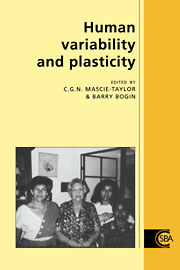Book contents
- Frontmatter
- Contents
- List of contributors
- Foreword
- 1 The pervasiveness of plasticity
- 2 Plasticity in early development
- 3 Plasticity in the growth of Mayan refugee children living in the United States
- 4 The place of plasticity in the study of the secular trend for male stature: an analysis of Danish biological population history
- 5 Plasticity, growth and energy balance
- 6 The study of migrants as a strategy for understanding human biological plasticity
- 7 Human migration: effects on people, effects on populations
- 8 The use of surnames in the study of human variation and plasticity
- 9 A biological anthropological approach to measuring societal stress of parasitic disease: a case study of schistosomiasis
- 10 Biological adaptability, plasticity and disease: patterns in modernizing societies
- 11 Human biological adaptability with special emphasis on plasticity: history, development and problems for future research
- Index
8 - The use of surnames in the study of human variation and plasticity
Published online by Cambridge University Press: 28 October 2009
- Frontmatter
- Contents
- List of contributors
- Foreword
- 1 The pervasiveness of plasticity
- 2 Plasticity in early development
- 3 Plasticity in the growth of Mayan refugee children living in the United States
- 4 The place of plasticity in the study of the secular trend for male stature: an analysis of Danish biological population history
- 5 Plasticity, growth and energy balance
- 6 The study of migrants as a strategy for understanding human biological plasticity
- 7 Human migration: effects on people, effects on populations
- 8 The use of surnames in the study of human variation and plasticity
- 9 A biological anthropological approach to measuring societal stress of parasitic disease: a case study of schistosomiasis
- 10 Biological adaptability, plasticity and disease: patterns in modernizing societies
- 11 Human biological adaptability with special emphasis on plasticity: history, development and problems for future research
- Index
Summary
Summary
A central idea in studies of human adaptation is that human beings can adjust to changing environmental conditions through a variety of mechanisms. Although debate continues regarding specific definitions and a general classification of modes of adaptation, most authors consider that human adaptation occurs via four broad processes: genetic evolution (natural selection, mutation, etc.), developmental plasticity, acclimatization, and cultural patterns of behavior (Frisancho, 1979). Other chapters in this book review these concepts, discuss alternative methods of study design and analysis, and provide case studies of human adaptation. This chapter looks at how surnames, a trait not affected by adaptive processes, can none the less be useful in studies of adaptation and plasticity. Surnames can provide information on genetic relationships between individuals and populations. This information can be useful in studies of adaptation by: (1) providing the expected patterns of variations under a neutral model (no adaptation); (2) providing estimates of demographic and cultural factors of interest to studies of variation and plasticity, especially mate choice and migration; and (3) providing estimates of genetic relationship between individuals for use in studies of genetic epidemiology.
Introduction
Studies of human variability and plasticity generally focus attention on traits of specific interest to hypotheses of plasticity and adaptive change. Relationships are examined between these traits and suggested adaptive or selective forces. Some classic examples include hemoglobin variants and malaria (Livingstone, 1958), body size and shape and climate (Roberts, 1978), skin color and ultraviolet radiation (Robins, 1991), and chest morphology and high-altitude environments (Frisancho, 1979). A key focus here is the identification and analysis of traits suspected to have significance, through the process of natural selection (genetic adaptation) and/or through developmental change (plasticity).
- Type
- Chapter
- Information
- Human Variability and Plasticity , pp. 146 - 158Publisher: Cambridge University PressPrint publication year: 1995
- 8
- Cited by



